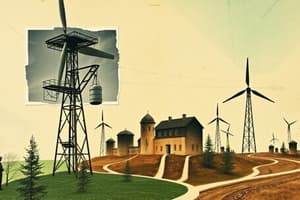Podcast
Questions and Answers
What makes renewable resources sustainable?
What makes renewable resources sustainable?
Which of the following is a form of renewable energy derived from the sun?
Which of the following is a form of renewable energy derived from the sun?
Which of the following is an example of a human-made resource?
Which of the following is an example of a human-made resource?
What is a characteristic of non-renewable resources?
What is a characteristic of non-renewable resources?
Signup and view all the answers
Which of the following is an example of a non-renewable resource?
Which of the following is an example of a non-renewable resource?
Signup and view all the answers
What characterizes non-renewable resources?
What characterizes non-renewable resources?
Signup and view all the answers
What are human-made resources?
What are human-made resources?
Signup and view all the answers
What is the role of human knowledge in utilizing natural resources?
What is the role of human knowledge in utilizing natural resources?
Signup and view all the answers
Which category of resources relies on human physical efforts?
Which category of resources relies on human physical efforts?
Signup and view all the answers
Why do non-renewable resources raise concerns about sustainability?
Why do non-renewable resources raise concerns about sustainability?
Signup and view all the answers
Study Notes
Unleashing Nature's Bounty: Understanding Natural Resources
When we talk about natural resources, we're looking at the wealth of elements, materials, and energy that Mother Nature provides for us—a treasure trove that can be harnessed to enrich our lives and drive progress. In this exploration, we'll delve into the two main categories of natural resources—renewable and non-renewable—as well as their human-made and human-powered counterparts.
Renewable Resources
Renewable resources are those that can be replenished naturally within a human lifetime. They include:
- Solar Energy: The sun's radiant energy, harnessed through solar panels, is a clean, abundant source of power.
- Wind Energy: The kinetic energy of wind can be converted into electricity using wind turbines.
- Hydro Energy: The energy of flowing water can be harnessed through dams and turbines.
- Biomass: The conversion of organic material such as wood, crops, and animal waste into energy through combustion, gasification, and other methods.
- Geothermal Energy: Heat stored within the Earth's crust, which can be used to generate power.
- Tidal Energy: The kinetic energy of the tides can be converted into electricity using tidal turbines.
Renewable resources are considered sustainable because they replenish themselves naturally, meaning they won't run out and can continue to meet future demands.
Non-Renewable Resources
Non-renewable resources, on the other hand, are those that cannot be replenished within a human lifetime. They include:
- Fossil Fuels: Coal, oil, and natural gas, which formed from the remains of ancient plants and animals.
- Nuclear Fuels: Uranium and other radioactive materials, which can be used to generate nuclear power.
- Metals: Though not entirely depleted, some metals such as tin, copper, and lead are finite resources that are mined and processed from their natural deposits.
Non-renewable resources are essential for our current way of life, but their finite nature raises concerns about their long-term availability and sustainability.
Human-Made and Human-Powered Resources
While the main focus of natural resources is on substances found in nature, it's also worth mentioning the resources developed by humans using natural resources, as well as those that rely on human power:
- Human-Made Resources: These are resources that are created through technological innovation and industrial processes. These include materials, products, and technologies that enhance or extend the properties of natural resources.
- Human-Powered Resources: These are resources that rely on human physical efforts, such as labor and muscle power, to convert natural resources into useful goods and services.
The Rise of Human-Made and Human Resources
Technological advancements have enabled the development of new resources and improved the efficiency of extracting, processing, and utilizing natural resources. For example, the use of renewable energy technologies such as wind and solar power has expanded rapidly, while the development of more efficient energy storage solutions and energy conversion methods has further improved our ability to harness these resources.
In addition to technological advancements, human resources such as knowledge, innovation, and labor have always been essential for the discovery, extraction, and utilization of natural resources. From the early days of mining to the complex engineering involved in extracting oil from the deep ocean floor, human knowledge and skill have remained irreplaceable factors in our ability to harness the resources of the natural world.
Conclusion
Understanding natural resources and their various categories is essential for managing our planet's resources more responsibly. As we seek to balance our demand for energy, materials, and services with the need to protect our environment, a deep understanding of natural resources can help us make informed decisions about the future of our world. Whether we're looking at renewable resources like solar and wind energy, non-renewable resources like fossil fuels and metals, or human-made and human-powered resources that utilize these natural materials, our ability to harness the wealth of the natural world is a key component of our collective future.
Studying That Suits You
Use AI to generate personalized quizzes and flashcards to suit your learning preferences.
Description
Dive into the world of natural resources and discover renewable resources like solar and wind energy, non-renewable resources like fossil fuels and metals, as well as human-made and human-powered resources. Learn how advancements in technology and human knowledge play a crucial role in harnessing the wealth of the natural world.




